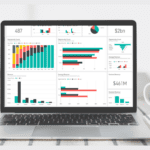Navigating the New Normal: Why CFOs are embracing Data Analytics and Power BI
The role of the Chief Financial Officer (CFO) has never been more complex or challenging. Driven by many interrelated factors such as rapid technology change, changing consumer expectations and regulatory shifts, Perth CFOs are turning to data analytics to help them navigate the ever evolving world of business.
Below we highlight the key forces propelling the need for data-driven decision-making and explore ways that Power BI can assist CFOs.
1. Complexity of the Business Environment
- Globalisation: Operating across multiple markets involves navigating diverse currencies, cultures and regulations. Power BI consolidates this data for clearer insights.
- Competition: The crowded market landscape necessitates that CFOs be more strategic and agile, which requires real-time data analytics. Power BI assists with visualising both real-time and historical data.
2. Volume and Variety of Data
- Big Data: The explosion in data volumes and sources offers the ability to generate highly granular insights, however this can only occur if the data is effectively analysed. Tools such as Power BI, when combined with Microsoft Fabric, make this possible.
- Unstructured Data: In addition to traditional metrics, CFOs must also manage unstructured data such as customer reviews and social media sentiment. With Power BI, Artificial Intelligence is able to ingest and summarise this for visualisation.
3. Technological Advancements
- Cloud Computing: The ability to access systems and data from anywhere at any time enables timely decisions. For meaningful insights the data must be analysed using tools such as Power BI.
- Machine Learning/AI: When historical insights are combined with human analysis algorithms that predict future trends have the ability to make planning more accurate. Tools such as Power BI allow for the visualisation of this as well as what-if scenario comparison from solutions such as Solver.
4. Regulatory Changes
- Compliance: Constantly evolving financial regulations require accurate data analytics for compliance. Power BI can be used to provide this information through its automated reporting.
- Transparency: Data analytics in Power BI can facilitate the transparency in financial and ESG reporting demanded by stakeholders.
5. Consumer Expectations
- Personalisation: Understanding consumer spending habits through data analytics is critical to meet expectations for tailored experiences. Once the data has been collected, this can be quickly and easily visualised in Power BI.
- Speed: Quick yet well-informed financial decisions are essential to meet the fast pace of consumer demands. CFOs must have the systems in place to collect accurate, timely, reliable data which can then be rapidly analysed using Power BI.
6. Operational Efficiency
- Cost Management: Analytical tools such as Power BI can highlight inefficiencies and areas for possible cost reductions.
- Resource Allocation: Efficient resource allocation, be it human capital or new technology investments, requires data analysis so that decisions are not just based on “gut feel” or ego.
- Opportunity Analysis: Data analytics can also assist with identifying opportunities and gaps in the market. Power BI’s visualisation tools make it much easier to identify these.
7. Financial Flexibility and Agility
- Real-Time Analysis: Power BI’s real-time data analytics allow CFOs to adapt quickly to market changes.
- Scenario Planning: Combined with budgeting and forecasting tools, such as Solver, advanced analytics facilitate more complex scenario planning, equipping CFOs for various market conditions. Solver allows CFOs to quickly and efficiently generate new scenarios to respond to new challenges and changing market conditions. Connecting Power BI to these allows CFOs to analyse and communicate the potential impact of decisions on the business.
8. Competitive Advantage
- Strategic Initiatives: Data insights can inform strategic decisions, like entering new markets or creating new revenue streams. Power BI allows CFOs and other decision makers to rapidly identify these.
- Innovation: Data can uncover avenues for innovation that can provide a competitive edge.
9. Risk Management
- Predictive Analytics: Power BI can use predictive models developed in tools such as Microsoft Azure ML or Fabric to assess and predict risks.
- Fraud Detection: Real-time fraud detection is possible with advanced analytics and machine learning models. Using these can help protect against significant financial losses.
10. Accountability and Performance Metrics
- KPI Tracking: Dashboards in Power BI help in tracking performance against set objectives. These can be integrated across the organisation to help align employees at all levels to achieve the organisational objectives.
- Benchmarking: Comparing company performance against industry standards enables CFOs to set realistic goals. Power BI provides an excellent way to communicate the organisation’s performance vs benchmarks.
The pressures exerted by these diverse factors make data analytics, supported by Power BI, an essential cornerstone for effective and forward-thinking CFO leadership. By embracing this data-centric approach, CFOs are better equipped to navigate the complexities of today’s rapidly evolving business landscape.
If you’re ready to find out how Microsoft Power BI can empower you effectively navigate the dynamic world of business, book a call with Jeff to discuss your needs.







